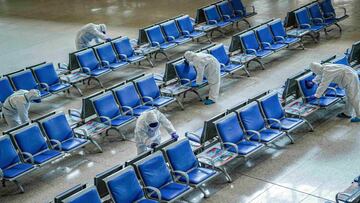How many people in Wuhan have been locked down again due to covid-19?
The Jiangxia district health authority has asked its million inhabitants not to leave their homes unless strictly necessary after four asymptomatic cases reported.

A district in the Chinese city of Wuhan went into lockdown on Wednesday for the first time since the covid-19 pandemic began in 2020, with measures not seen since April of that year imposed in the city where scientists believe the novel SARS-CoV-2 coronavirus originated in a wholesale seafood market. Jiangxia has placed its roughly one million inhabitants under confinement after four asymptomatic cases of covid-19 were registered there.
Authorities in Jiangxia have asked residents to remain at home and to avoid going out unless strictly necessary. Other measures put in place as a precaution include shutting down public transport and closing entertainment venues for three days.
China’s policy to tackle the coronavirus is known as zero-covid strategy and aims to eradicate coronavirus infections entirely. Beijing’s preference is not to live with the virus as many countries have already resigned themselves to doing, but to reach a stage where there are no further covid-19 infections in the country. To travel from many countries to China it is necessary to transit through a third country en route and many other requirements are in place.
Analysis of spatial distributions of early #COVID19 cases and environmental samples from the Huanan market point to the market as the epicenter of #SARSCoV2 emergence, from activities associated with wildlife trade. https://t.co/tykjmEOGxW @MichaelWorobey @K_G_Andersen pic.twitter.com/THYDkLualC
— Science Magazine (@ScienceMagazine) July 26, 2022
Two studies point to Wuhan as covid ground zero
The latest lockdown in Wuhan has raised alarms again a day after Science published two studies that point to Wuhan as the city in which covid-19 originated. The scientific community has long been more or less certain that SARS-CoV-2 first sprung up in the Chinese city, but the most recent investigations, led by Michael Worobey and Jonathan Pekar, have for the first time looked at the spatial, environmental and molecular analyzes of the Huanan wholesale seafood market, where the virus is widely believed to have infected a human with the world’s first case of covid-19.
Related stories
The studies conclude that it is very likely SARS-CoV-2 was present in live mammals sold in the Huanan market at the end of 2019, while also suggesting that the genomic diversity of SARS-CoV-2 prior to February 2020 likely consisted of only two distinct viral lineages, designated A and B.
But the World Health Organization (WHO) has said more research is needed to understand how the the start of the pandemic came about. “Unfortunately, we need more studies to be done in China and other places to really understand the early phases,” the head of the WHO anticovid technical team, Maria Van Kerkhove, said Wednesday. “There are still many unanswered questions and we welcome further scientific studies to get closer to an understanding of how the pandemic started”, Van Kerkhove added.